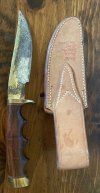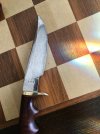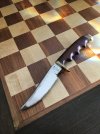donnord
Gold Member
- Joined
- Dec 22, 2007
- Messages
- 493
I have this Ralph Bone knife on the the way. Based on the sellers pics it has considerable oxidation on the blade. I cant really tell from the pics but there is likely some pitting. I am not really interested in sanding the pits to get rid of them as I don't want to risk ruining the blade. I intend for this knife to be a user. I did quite a bit of reading on here and elsewhere. Some say Bar Keepers Friend, 0000 steel wool and oil, etc. Many of the posts are a few years old, most likely not much has changed. I would appreciate any advise y'all may have. Thanks.





